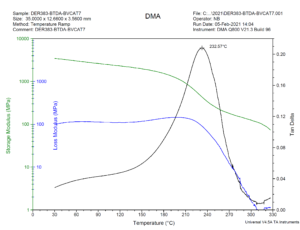Welcome to the sixth entry of The Dianhydrides Diaries, a bi-weekly series that will explore all the benefits of dianhydrides, along with the chemistry, applications, tips, and advice on how to gain a competitive edge with your next project.
In earlier entries in this series, I described the high-temperature performance of epoxy formulations cured with dianhydrides. The high crosslink densities achieved from the use of dianhydrides lead to high glass-transition temperatures (Tg) and high retention of strength at elevated temperatures, at times, beyond the Tg itself. The latter feature comes about from a relatively high rubbery plateau modulus for such highly crosslinked epoxies. As an example, Figure 1 shows the dynamic modulus and tan(δ) vs. temperature for standard liquid epoxy cured with BTDA (benzophenonetetracarboxylic dianhydride).
Figure 1. DMA data showing dynamic shear moduli and tan(δ) vs. temperature for standard liquid BPA epoxy resin (EEW 181) cured with BTDA (0.5 A/E ratio) at 200°C. Note the high rubbery plateau for storage modulus, indicating a fairly strong material even above the Tg. (click figure to enlarge)
For an epoxy adhesive to benefit from a dianhydride, it does not have to use an all or nothing approach. For some adhesive applications, the use of a solid dianhydride as the only curing agent may not even be practical and that is when a combination with a liquid monoanhydride can be the best option. Table 1 shows three example formulations using a dianhydride in combination with MTHPA, which is a popular liquid anhydride for epoxy formulations.
Table 1. Example formulations demonstrating the combined use of dianhydride and monoanhydride curing agents.
| Component | Weight | Weight | Weight |
| Part 1: | |||
| BPA liquid epoxy resin, EEW 189 g/eq | 100.0 | 100.0 | 100.0 |
| Part 2: | |||
| BTDA* (dianhydride) AEW 161 g/eq | 21.3 | 26.5 | 29.8 |
| MTHPA+ (monoanhydride), AEW 166 g/eq | 41.7 | 32.5 | 25.0 |
| Latent cure accelerator, as needed | —- | —- | —- |
| Thickeners, fillers, additives, as needed | —- | —- | —- |
| A/E Ratio for formulations: | 0.72 | 0.68 | 0.63 |
| Cure cycle: 10 minutes @ 150°C; post-cure @ 200°C suggested for best properties | |||
| Expected Tg = 150°C-180°C based on overall formulation and cure conditions. | |||
* BTDA: benzophenonetetracarboxylic dianhydride
+ MTHPA: methyl tetrahydrophthalic anhydride
In these examples, the liquid anhydride serves as a low viscosity reactive diluent and carrier in which the dianhydride particles are dispersed to form a paste curative. The ratio of the dianhydride to liquid anhydride in the blend can be optimized, based upon the requirements of the application, e.g., balancing high Tg with handling characteristics or for optimizing mechanical properties. Due to the relatively low viscosity of MTHPA, a substantial amount of BTDA can be dispersed in it allowing the formulator the freedom to maximize Tg while keeping the adhesive viscosity manageable.
And this concept is effective also for applications that go beyond adhesives– e.g., encapsulation resins or composites resins for prepregs or resin transfer molding (RTM), etc.



